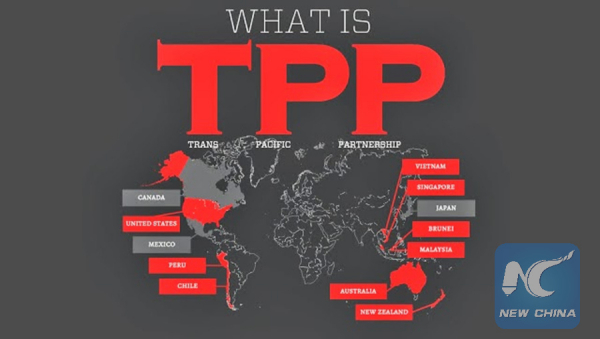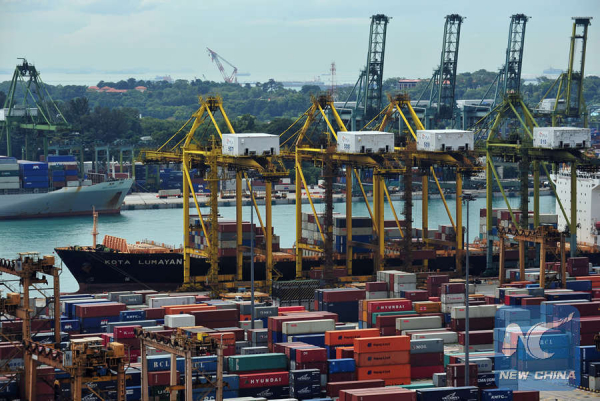
(Web photo shows the 12 countries involved in the TPP)
BEIJING, Oct. 6 (Xinhua) -- The Trans-Pacific Partnership (TPP) free trade pact was finally sealed by 12 Pacific Rim nations on Monday after more than five years of negotiation. The following are several things about the deal you need to know.
Q: What is TPP?
A: The free trade agreement was originally initiated by Chile, Singapore, New Zealand and Brunei in 2005, featuring elimination of tariffs among member economies.
In 2008, with the participation of the United States, the TPP has gained more focus and later received application from Australia, Peru, Vietnam and Japan.
The agreement involves 12 countries: U.S., Japan, Australia, Canada, Singapore, Brunei, Malaysia, Vietnam, New Zealand, Chile, Mexico and Peru, encompassing 40 percent of the world economy.
The pact covers a range of legal provisions, including investment, service, electronic commerce, government procurement, intellectual property and environment.
Market access to agricultural products, the country-of-origin rule in auto manufacturing industry, and intellectual property protection in pharmaceutical industry have been monumental sticking points throughout the entire negotiations.
The agreement will allow great market exposure, as up to 18,000 kinds of tariff are to be reduced or eliminated under the terms of the TPP.

Trade ministers of the United States and 11 other Pacific Rim countries attend a press conference after negotiating the Trans-Pacific Partnership (TPP) trade agreement in Atlanta, the United States, on Oct. 5, 2015. (Xinhua/Gao Pan)
Q: What are the main features of the TPP?
A: One of the main features of the TPP is setting up standards and rules and reshaping the trade rules in Asia-Pacific and the world with "full coverage" and "high standard."
In terms of "full coverage," the TPP includes many more fields than most free trade treaties, such as investment and competition policy, technical trade barrier, food safety, intellectual property rights, green growth and labor protection.
The TPP also features "high standard" in terms of openness, for example in environmental protection and government purchase. Experts said the high standard represents the trend of international trade, but also surpassed the ability and condition of some developing members.
Q: What challenges remain after the TPP deal was reached?
A: The first challenge is the deal still need to be ratified by 12 member states, which faces difficult political wrestle in each countries.
For example, in the United States, several Republican and Democratic presidential candidates have begun attacking the TPP, raising concerns about potential job losses in the United States.
Meanwhile, trade unions, environmental groups, consumer and heath care organizations across the U.S. have come together to organize protests against the TPP out of various concerns.
As U.S. President Barack Obama has to notify Congress at least 90 days before he can sign the TPP agreement, it still has a long way to go before the deal reaches Congress for possible ratification.
The earliest date for a final TPP vote in U.S. Congress would be in February 2016.
The second challenge is that the TPP could create new imbalance and uncertainty between developed and developing member states.
Some experts have voiced concerns that the TPP, demanding to reduce trade protection, investment regulation and promote financial liberalization, will not be in conformity with the development stage of many emerging economies, and even put companies in developed countries at risk.
Joseph Stiglitz, the famed Nobel Prize-winning economist, slammed the Peruvian negotiation tactics, describing them as "capitulating to the demands of developed countries."
He said the TPP, if signed in its current form, would see "the theft of genetic material from the Peruvian Amazon ...to benefit big pharmaceutical companies and drive up the costs of generics."

File photo taken on Dec. 7, 2013 shows the port of Singapore. The TPP Ministers meet in Singapore from Dec. 7 to 10 for advanced stage negotiations. (Xinhua/Then Chih Wey)
Q: How will TPP affect China?
A: China sees the TPP as one of the key free trade agreements for the Asia-Pacific region and is open to any mechanism that follows rules of the World Trade Organization and can boost the economic integration of the Asia-Pacific, said its Ministry of Commerce on Tuesday.
China hopes the TPP pact and other free trade arrangements in the region can boost each other and contribute to the Asia-Pacific's trade, investment and economic growth, said the ministry.
China has not ruled out joining the TPP at a proper time. The deal might bring certain impact to China's export in the short term, however, within the context of the globalization, no multilateral trade mechanism could exclude exterior countries and regions from international trade system in the long run.
China has developed a deep-level, high standard and all-dimensional overseas trade structure, as it has signed free trade agreements with Switzerland, South Korea and Australia, with advancing talks on a China-U.S. and China-Europe investment treaty, Shanghai free trade zone, regional comprehensive economic partnership and various economic cooperative arrangements.
Some experts have pointed out the the TPP will have a limited impact on China.